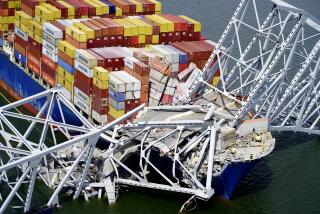A Tragic, 118-Count Indictment of the Russian Nuclear Navy
- Share via
The tragic spectacle of the Russian navy’s thus-far ineffective efforts to save the 118 crew members on the Kursk nuclear submarine raises serious questions about Russia’s continued ability to operate its nuclear fleet safely. An exercise aimed at showing Russia’s nuclear might has turned into a human disaster, with Russia now appealing belatedly to Britain for emergency assistance in the rescue effort. But this call may be too late.
Unfortunately, the underlying problems this incident has exposed within the Russian navy go far deeper. The areas of information policy, maintenance, nuclear safety and personnel all raise serious outside concerns.
In terms of information policy, news coming from the Russian government bears many of the signs of the Chernobyl disaster. Despite the fact that the vessel had apparently sunk Saturday morning, the Russian government released information only Monday morning. It then indicated only that there had been a sinking, but that there had been no loss of life and that the navy had all of the equipment it needed to conduct a rescue operation. Government reports also claimed that the navy was in full communication with the crew. By Wednesday, it appeared that communication has been sporadic and limited to periodic tapping on the hull in semi-decipherable Morse code.
The cause of the accident also was in dispute. Initial reports indicated a torpedo problem. Later, however, the government attempted to divert responsibility by claiming that the vessel probably had collided with another vessel, possibly a foreign submarine spying on the exercises. On Tuesday, a new theory floated by the government suggested a collision with a World War II-era mine. Evidence from the site, however, indicated a large explosion on the submarine itself, returning the focus to the torpedo room and a possible propellant, weapon or oxygen tank explosion.
On Wednesday, as hope seemed to evaporate, the Russian government suddenly announced that the crew had enough oxygen to last until Aug. 25 and that the lack of tapping on the hull likely meant that the crew was conserving energy. None of these games with the media have impressed the families of the sailors.
Then there is the problem of rescue equipment. During the Cold War, the Soviet Union developed a series of mini-submarines and other submersibles that would have been much more capable of conducting a rescue operation than the old-fashioned rescue bell that the Russians have tried to lower from a surface ship. Given the rough seas and the weather, this operation has proved extremely difficult. The mini-submarines, though, are not available because they have been mothballed due to a lack of funding.
One-third of the Kursk’s crew are reported to be new recruits from the city of Kursk. In the new Russian financial environment, the navy has accepted city sponsorship of vessels in order to guarantee food supplies and even needed equipment, which are funded by local governments eager to keep their young men out of Chechnya and in reasonable livable conditions during their required military service. This is not the way to fund a modern nuclear navy.
In terms of nuclear threats, fortunately, there is no information to suggest that the Russians had nuclear weapons aboard. The Kursk was commissioned in 1995, four years after Russia and the United States agreed (under the George Bush administration) to remove all short-range nuclear weapons from naval vessels. Also, given that this submarine’s mission is to defend against NATO aircraft carriers and other surface ships with cruise missiles and torpedoes, it does not need nuclear weapons to do its job.
In terms of the reactor, there is no evidence yet of any release of radioactivity, thanks to the rapid (and possibly automatic) shutdown of the reactor soon after the explosion that caused it to take on water and sink. But the crew is now cut off from both electricity and the oxygen generation equipment that normally operates on the vessel.
Problems in the nuclear sector are rampant in the Russian navy. With 179 nuclear submarines decommissioned, less than half of them have been defueled. This means that almost 100 nuclear submarines are docked in various Russian harbors with only skeleton crews and still functioning nuclear reactors. Given the slow progress of dismantlement work, which is only moving forward with ballistic-missile-carrying submarines because of the U.S. assistance, the threat of a power outage at these facilities and the shutdown of safety systems is a constant concern.
Yet perhaps the most serious problem in the Russian navy is personnel. Conscripts are poorly trained and abysmally paid. This may explain the case in Kamchatka earlier this year, when two sailors broke into a decommissioned nuclear submarine to steal materials for sale. They entered the reactor compartment and tried to raise the reactor control rods, which could have caused a serious nuclear incident. It was only chance that an engineer had come aboard to weld down the lever the day before. The sailors did manage to remove a number of shiny golden plates used to calibrate radiation control equipment; investigators found these radioactive metals under their mattresses.
What the Kursk incident and the other problems highlight is that Russia no longer can maintain a major nuclear fleet. Its recent appeal to Britain and other NATO members for assistance in saving its own sailors who lie only 350 feet down, right off the Russian coast, is a humiliating admission of this fact.
If the lives of the Kursk crew are to have some greater meaning, they will promote a thorough reevaluation by the Vladimir V. Putin administration of the Russian nuclear fleet, leading to more sensible measures for significant downsizing and refocusing attention on safety. The ultimate irony is that the very navies that Russia was seeking to impress are the ones that are coming to save its sailors.
More to Read
Sign up for Essential California
The most important California stories and recommendations in your inbox every morning.
You may occasionally receive promotional content from the Los Angeles Times.










